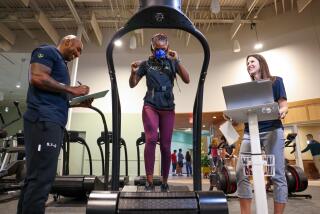Home Health Care Gets Shot in Arm : Newport Beach Firm Is Latest to Join Trend
- Share via
Hayden R. Miller was recuperating from triple bypass heart surgery this summer when he started to feel chills and fever.
Instead of checking into a hospital for treatment of what turned out to be a heart valve infection, Miller was sent home with equipment and instruction on self-administering antibiotics. Three times a day the Riverside man inserted a needle-ended rubber tube into a catheter lodged in his arm and for 35 to 40 minutes pumped antibiotics into his body.
Three weeks later, with the help of H.M.S.S., a home intravenous therapy firm, Miller was cured.
On Sunday, it was announced that Secomerica Inc., the Newport Beach parent of Westec Security Inc., had reached an agreement to acquire Houston-based H.M.S.S. for about $255 million.
Industry analysts consider the purchase price to be a premium for a company that is expected this year to generate only $50 million in revenue. But they said the price did not reflect the current earnings and revenue of H.M.S.S. so much as the company’s recent and projected growth in a fast-growing industry.
Revenues Expanding
With annual revenues from home infusion therapy totaling about $1.2 billion in 1988, analysts are expecting sales to continue to grow industrywide by 25% to 30% a year. Some companies are doing even better. Take the case of H.M.S.S., which last year saw its revenues expand by 70% and expects them to grow this year by 60%.
Secomerica, a unit of Tokyo-based Secom, a $1-billion-a-year conglomerate, is not the only well-heeled firm getting into the intravenous therapy market. Baxter International Inc. of Deerfield, Ill., two years ago bought Caremark Inc. of Newport Beach for $500 million.
Caremark, the oldest and by far largest company in the home intravenous business, claiming about 40% of the market, has 80 branches in the nation, including four Southern California centers in Irvine, Glendale, San Diego and San Bernardino.
And Hoffmann-LaRoche Inc., the giant pharmaceutical firm, last spring created a new subsidiary to enter the home intravenous therapy business. Since then, the company has opened eight regional service centers, including one in Irvine, and it aims to have more than 36 centers situated in all the major population centers of the country by 1992.
Growing Popularity
Home health care has become a popular way to check soaring medical costs--allowing them to get nutrients, medications and fluids intravenously at home rather than in the hospital, generally at half the cost.
R. Dale Ross, president and chief executive of H.M.S.S., said prices for home intravenous therapy range from $250 a day for administration of pain killers to $700 a day for aggressive chemotherapy treatment.
“The cost of treating the patient in the home is about half the cost of hospital treatment,” said Rae E. Alperstein, vice president and health care services industry analyst with Bateman Eichler in Los Angeles. “The insurance companies like it, the government likes it and the patient would rather be at home.”
Patients with infections that can be cured short-term, as well as those with chronic ailments such as cancer and AIDS, are usually referred to home intravenous therapy services. The larger companies like Hoffmann-La Roche, H.M.S.S. and Caremark have service centers in major metropolitan areas. Each center has its own pharmacy to mix the drugs and a staff of registered nurses to teach patients how to use the intravenous equipment.
Patient-Administered Care
Home intravenous patients wear a catheter that the nurse inserts into an arm and changes every few days. The patient then hooks himself up to the intravenous equipment according to a schedule. Any time of day, he can call a nurse or pharmacist if he has any questions or needs help.
The industry has emerged with the development of computer-assisted technology that that has made it much easier for patients to administer the treatments.
“The equipment has been computerized and programmed so a patient only has to push one button to get exactly what the doctor ordered,” said Karen Campbell, manager of the H.M.S.S. center in Irvine.
In home cancer therapy, a pump the size of a pocket calculator is worn around the patient’s waist and connected to an intravenous tube. The pump is programmed to continuously dispense the cancer-treating drugs at the optimum dose. This kind of ongoing treatment often prevents nausea and other negative side effects that patients experience when they receive larger, infrequent doses of chemicals in the hospital, said Hoffmann-La Roche spokeswoman Nancy Mattison.
High Profit Margin
The high-tech nature of home-based intravenous therapy makes it a highly profitable business, health care analysts said.
“Intravenous treatment has the highest profit margin in home health care,” said Joseph Keenan, president of the American Academy of Home Care Physicians, an 18-month-old professional organization with 150 physician members.
By contrast, the general home care industry that provides low-skilled nursing and housekeeping has suffered from cost-cutting competition that has seriously squeezed its profit margins, analysts said.
The prospect of profits has attracted a myriad of players, big and small, onto the home therapy field. Besides the big hitters like Baxter and Hoffmann-La Roche, there are hospitals that want to diversify beyond the less profitable acute care services and mom-and-pop enterprises that operate out of neighborhood pharmacies.
“We see a lot of new companies starting up, especially in the last two years,” said Chris Patrick, branch operations manager for Caremark’s Irvine center. “Most everyone is giving it a try.”
More to Read
Inside the business of entertainment
The Wide Shot brings you news, analysis and insights on everything from streaming wars to production — and what it all means for the future.
You may occasionally receive promotional content from the Los Angeles Times.










